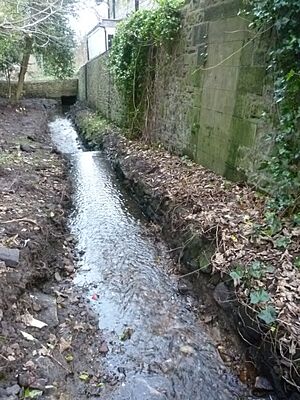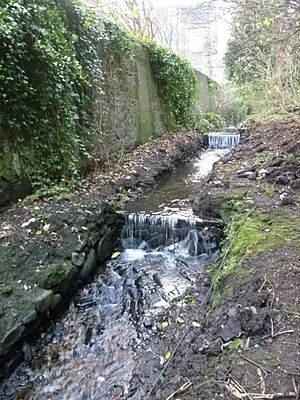Jordan Burn facts for kids
The Jordan Burn is a stream in Edinburgh, Scotland. For much of its journey, it flows underground in a pipe, which is called a culvert. This stream runs through the Victorian area of Morningside. Until 1856, the Jordan Burn marked the southern edge of Edinburgh city. It eventually flows into another stream called the Braid Burn.
What's in a Name?
The name "Jordan Burn" first appeared on a map of Edinburgh in 1753. It was named this because it flowed between areas called 'Egypt' and 'Canaan'. These names come from the Bible.
Before it was called the Jordan Burn, it was known as the Pow Burn. This was back in 1586, when the land that became Morningside was first divided up by Edinburgh's leaders. Some people also used to call it the "Braid Burn" because it was the northern border of the Braid Estate. But it's important not to mix it up with the main Braid Burn, which flows further south.
Where Does the Jordan Burn Flow?
The Jordan Burn starts on Craighouse Hill. From there, it flows east under Myreside Road. It then runs along the southern edge of the Royal Edinburgh Hospital grounds. Here, another small stream, the Comiston Burn, joins it.
The burn then goes under Morningside Road, between Jordan Lane and Nile Grove. It continues under Woodburn Terrace and through the Astley Ainslie Hospital grounds, where you can see it above ground for a short distance.
After that, it flows through Blackford until it reaches Mayfield. At this point, it goes back to its old name, the Pow Burn. After leaving Newington, it joins the Braid Burn at Peffermill. From there, it turns northeast. When it reaches Duddingston Mills, its name changes again to the Figgate Burn. Finally, the Figgate Burn flows into the Firth of Forth (a large sea inlet) at Portobello. In total, the Jordan Burn and its connected streams travel about ten miles!
Biblical Names in Morningside
The name "Jordan" is part of a group of biblical names found in the Morningside area. These include places like 'Eden', 'Paradise', 'Nile', 'Salem', 'Bethel', 'Hebron', 'Goshen', and 'Zion Mount'.
These names seem to be linked to a farm called 'Egypt'. This farm was located just south of the Jordan Burn, where Nile Grove and Woodburn Terrace are today. The farm buildings were taken down in the 1890s as Edinburgh grew southwards.
The 'Egypt' farm was first mentioned in city records in 1585 as "Littill Egypt". Some people think this name might mean that Romani people (sometimes called "gypsies" in the past) lived on the land in the 1500s. Leaders of Romani communities sometimes called themselves Kings of 'Little Egypt'.
In 1661, the land just north of the farm, across the Jordan Burn, was called "Canaan". This shows how biblical names started to spread in the area. Many more biblical names were added during the Victorian period, probably by people living in Morningside who wanted to keep this tradition going. This led to the area being known as Edinburgh's "Bible Belt" because of its strong religious connections.



